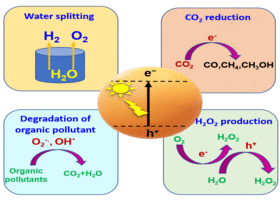Novel Photocatalysts for Environmental and Energy Applications 2021
A special issue of ChemEngineering (ISSN 2305-7084).
Deadline for manuscript submissions: closed (31 May 2022) | Viewed by 9178

Special Issue Editor
Special Issue Information
Dear Colleagues,
Recently, numerous photocatalyst materials have been studied for their remarkable applications in photocatalytic degradation of toxic pollutants, photocatalyst adsorbents for wastewater treatment, hydrogen production, conversion of solar energy into electric energy, and reduction of CO2 to organic fuels (e.g., methane, methanol, formate, or carbon monoxide).
This Special Issue is dedicated to a wide range of strategies that are used due to the free availability of solar radiation and its significant benefits in terms of several applications, such as environmental remediation, synthesis of chemicals, green energy generation, and energy storage. This covers the design, preparation, and characterization of novel photocatalytic materials produced through cost-effective and fully scalable synthesis approaches with controllable dimensions and properties suitable for a wealth of applications in photocatalysis and energy. The synthesis of novel materials with a set of unique and exclusive advantages, such as high catalytic activity, impressive selectivity, long-term durability, and environmental sustainability, are of profound and immediate interest.
Submit your paper and select the Journal “ChemEngineering” and the Special Issue “Novel Photocatalysts for Environmental and Energy Applications 2021” via: MDPI submission system. Please contact the special issue editor (spring.deng@mdpi.com) for any queries. Our papers will be published on a rolling basis and we will be pleased to receive your submission once you have finished it.
Dr. Tayyebeh Soltani
Guest Editor
Manuscript Submission Information
Manuscripts should be submitted online at www.mdpi.com by registering and logging in to this website. Once you are registered, click here to go to the submission form. Manuscripts can be submitted until the deadline. All submissions that pass pre-check are peer-reviewed. Accepted papers will be published continuously in the journal (as soon as accepted) and will be listed together on the special issue website. Research articles, review articles as well as short communications are invited. For planned papers, a title and short abstract (about 250 words) can be sent to the Editorial Office for assessment.
Submitted manuscripts should not have been published previously, nor be under consideration for publication elsewhere (except conference proceedings papers). All manuscripts are thoroughly refereed through a single-blind peer-review process. A guide for authors and other relevant information for submission of manuscripts is available on the Instructions for Authors page. ChemEngineering is an international peer-reviewed open access monthly journal published by MDPI.
Please visit the Instructions for Authors page before submitting a manuscript. The Article Processing Charge (APC) for publication in this open access journal is 1600 CHF (Swiss Francs). Submitted papers should be well formatted and use good English. Authors may use MDPI's English editing service prior to publication or during author revisions.
Keywords
- photocatalytic degradation
- organic pollutants
- green energy generation
- CO2 reduction
- hydrogen production
Benefits of Publishing in a Special Issue
- Ease of navigation: Grouping papers by topic helps scholars navigate broad scope journals more efficiently.
- Greater discoverability: Special Issues support the reach and impact of scientific research. Articles in Special Issues are more discoverable and cited more frequently.
- Expansion of research network: Special Issues facilitate connections among authors, fostering scientific collaborations.
- External promotion: Articles in Special Issues are often promoted through the journal's social media, increasing their visibility.
- Reprint: MDPI Books provides the opportunity to republish successful Special Issues in book format, both online and in print.
Further information on MDPI's Special Issue policies can be found here.





